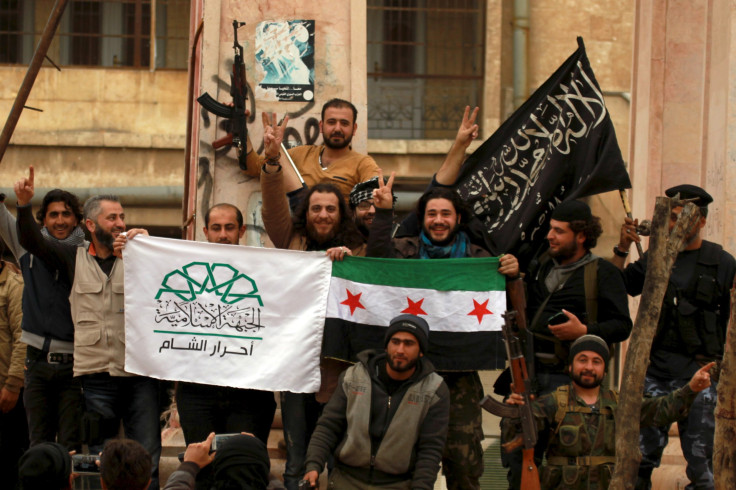Syrian Rebel Groups Merge To Take On Assad In Dera’a, But Deep Divisions Remain

Syrian rebels launched a major joint offensive Wednesday against President Bashar Assad’s forces in Dera’a, south of the capital Damascus, where the revolution began in 2011. The two main factions now fighting together against the regime there are among the strongest opposition groups in the country, and they may have a chance to inflict severe damage on the Assad’s forces. Yet, even though they were formed from the remnants of the original Free Syrian Army (FSA), they have different ideologies and are not ready to share leadership, fighters with both factions told International Business Times.
Jaysh al Fatah (Arabic for “Army of Conquest”) partnered with the group known as the Southern Front -- as well as with some battalions in the al Qaeda offshoot in Syria, known as Jabhat al Nusra or the Nusra Front -- in a new offensive called Southern Storm.
Despite their disagreements, Jaysh al Fatah and the Southern Front offer what may be the best opportunity for the opposition to topple Assad’s regime in Damascus, but that poses a policy dilemma for the U.S., which wants to destroy the Islamic State group before focusing on the Syrian regime. The rebel offensive began Wednesday night and continued throughout Thursday. Its immediate goal is to take control of a major supply route that leads directly to Damascus, although the rebels had yet to reach that area as of Thursday night.
The alliance between Jaysh al Fatah and the Southern Front is a new one, formed within the past two months. The two groups may have banded together to maximize their chances against Assad, but they stand in stark contrast to each other in many ways.
Disagreements started before the battle was even joined Wednesday, when Jaysh al Fatah and Southern Front sparred over which of them would make the announcement about the launch of the offensive. It is unclear how involved the Nusra Front is in the battle: Some of its battalions frequently coordinate with more extremist elements within Jaysh al Fatah, such as the group known as Ahrar al-Sham.
Jaysh al Fatah, backed by Turkey, Saudi Arabia and Qatar, has so far focused its efforts in the northern part of the country, taking on the Islamic State group and Assad in major cities such as Aleppo and Idlib. After a string of big victories within the past five months, the rebel group is one of the leading forces in the country, at least in the north. Many of its battalions are religiously very hardline, and some of its members preach extremist Islam.
In contrast, the Southern Front is the only nonhardline Islamist rebel group. It operates predominantly in the southern part of the country, controlling land from the border of Jordan to the Golan Heights. Many of the group’s members served with the original FSA battalions that spearheaded the initial opposition movement in 2011.
For years, the FSA was the leading rebel force in Syria. Factions within the group held discussions with Western countries and even entertained the idea of negotiating with Assad. The FSA lobbied for American weapons, and the U.S. established a CIA program that sent arms to vetted moderate battalions within the organization.
But the emergence of the better-armed, ruthless Islamic State group on the battlefield in Syria last year marked the beginning of the end for the opposition groups the U.S. dubbed the “moderate rebels.” Since then, the FSA has all but dissipated.
Now, Jaysh al Fatah and Southern Front are the only rebel umbrella organizations in Syria that could conceivably receive Western support in the future. Some of the battalions in Jaysh al Fatah are in discussions with the U.S. about taking part in a training program in Turkey, although the program has yet to begin. Others are already being trained at a military base in Jordan.
But the U.S. is not close to arming the Southern Front, at least not yet, because if the group were to succeed in its immediate goal of chasing Assad out of Damascus, then a space may open for the Islamic State group to take over the capital, something the U.S. wants to avoid at all costs. That’s why Washington is focusing on getting rid of the militant group formerly known as either ISIL or ISIS before pursuing Assad.
Without more support, rebels in the Southern Front say they will soon have no other option but to partner with more extremist, and rich, groups such as the Nusra Front. That has Syria’s neighbors, including U.S. allies, worried.
“I think this is more about our regional allies tolerating more local, nationalist forces to directly coordinate with Jabhat al-Nusra and Ahrar al-Sham,” said Andrew J. Tabler, an expert on Syria and senior fellow at the Washington Institute for Near East Policy, a think tank based in Washington. “This is the same formula that has pushed regime forces back in Idlib. The formula has been effective, but it makes U.S. policy options with the armed opposition that much more complicated.”
© Copyright IBTimes 2024. All rights reserved.





















